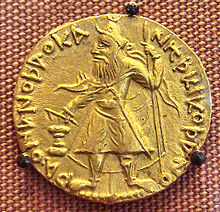Sho (letter)

 | ||||||||||||||||||||||||||||||||||||||||||||||||
| Greek alphabet | ||||||||||||||||||||||||||||||||||||||||||||||||
|---|---|---|---|---|---|---|---|---|---|---|---|---|---|---|---|---|---|---|---|---|---|---|---|---|---|---|---|---|---|---|---|---|---|---|---|---|---|---|---|---|---|---|---|---|---|---|---|---|
| ||||||||||||||||||||||||||||||||||||||||||||||||
| History | ||||||||||||||||||||||||||||||||||||||||||||||||
| ||||||||||||||||||||||||||||||||||||||||||||||||
| Diacritics and other symbols | ||||||||||||||||||||||||||||||||||||||||||||||||
| Related topics | ||||||||||||||||||||||||||||||||||||||||||||||||
The letter ϸ (sometimes called sho or san) was a letter added to the Greek alphabet in order to write the Bactrian language.[1] It was similar in appearance to the Anglo-Saxon and Icelandic letter thorn (þ), which has typically been used to represent it in modern print, although they are historically unrelated. It probably represented a sound similar to English "sh" ([ʃ]). Its conventional transliteration in Latin is ⟨š⟩.[2]


Its original name and position in the Bactrian alphabet, if it had any, are unknown. Some authors have called it "san", on the basis of the hypothesis that it was a survival or reintroduction of the archaic Greek letter San.[3] This letter ϸ closely resembles, perhaps coincidentally, the letter ⟨𐊮⟩ of the Greek-based Carian alphabet which may have also stood for [ʃ]. The name "sho" was coined for the letter for purposes of modern computer encoding in 2002, on the basis of analogy with "rho" (ρ), the letter with which it seems to be graphically related.[1] Ϸ was added to Unicode in version 4.0 (2003), in an uppercase and lowercase character designed for modern typography.
Other representations of [ʃ] in the Greek alphabet
The modern Cypriot Greek dialect also has a voiceless postalveolar fricative, represented with the combining caron ⟨ˇ⟩, by the authors of the "Syntychies" lexicographic database at the University of Cyprus, [4] e.g. μάσ̌σ̌αλλα [ˈmaʃːalːa] "mashallah". When diacritics are not used, an epenthetic ⟨ι⟩ – often accompanied by the systematic substitution of the preceding consonant letter – may be used to the same effect, e.g. Standard Modern Greek χέρι [ˈçeɾi] → Cypriot Greek σιέρι [ˈʃeɾi].
The Tsakonian language, considered a Hellenic language or a very divergent dialect of Greek, has a voiceless postalveolar fricative. It is spelled ⟨σχ⟩ or, in Thanasis Costakis' orthography, ⟨σ̌⟩.
| Appearance | Code points | Name |
|---|---|---|
| Ϸ | U+03F7 | GREEK CAPITAL LETTER SHO |
| ϸ | U+03F8 | GREEK SMALL LETTER SHO |
References
- ^ a b c Everson, M. and Sims-Williams, N. (2002) “Proposal to add two Greek letters for Bactrian to the UCS”,ISO/IEC JTC1/SC2/WG2 N2411.
- ^ Skjærvø, P. O. (2009). "Bactrian". In Brown, Keith; Ogilvie, Sarah (eds.). Concise encyclopedia of languages of the world. Oxford: Elsevier. p. 115. ISBN 9780080877754.
- ^ Tarn, William Woodthorpe (1961). The Greeks in Bactria and India. Cambridge: Cambridge University Press. p. 508. ISBN 9781108009416.
- ^ Themistocleous et al. 2012, pp. 263–264.
- Themistocleous, Charalambos; Katsoyannou, Marianna; Armosti, Spyros; Christodoulou, Kyriaci (7–11 August 2012). Cypriot Greek Lexicography: A Reverse Dictionary of Cypriot Greek (PDF). 15th European Association for Lexicography (EURALEX) Conference. Oslo, Norway. Archived from the original (PDF) on 6 August 2016. Retrieved 12 February 2013.